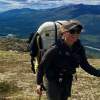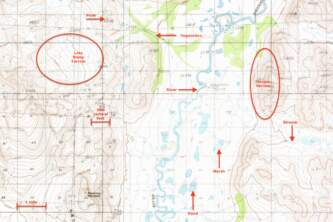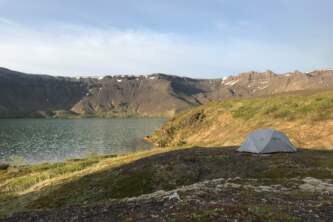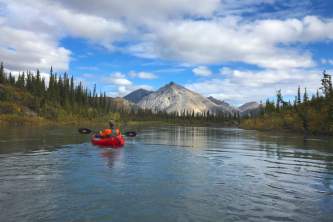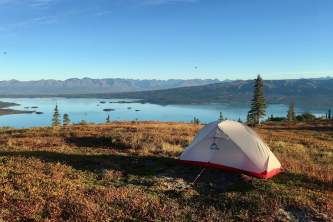Quality, well-fitting equipment and clothing can be the difference between an incredible Alaskan backpacking trip or a truly miserable experience. The exact equipment necessary for your trip will depend on your preference, but we think that this gear list is a great place to start!
Gear and Equipment
- Backpack. Use a well-fitting backpack; you may even want to visit a gear store and get a professional fit. Look for a range of 40-70L of capacity. Remember that bear-resistant food containers can take up a significant amount of space.
- Waterproof pack cover. Pick a pack cover that's large enough for your pack plus whatever items you plan to strap to its exterior. Alternately, line your backpack with a trash compactor bag and pack all items inside of that bag or invest in a waterproof backpack.
- Water bottle or hydration bladder. Usually, 1-2L is the maximum amount of water you'll need to carry at any time. If using a hydration bladder, pack your full bladder first; it's next to impossible to squeeze a full hydration bladder into a fully loaded pack.
- Tent. A tent that can stand up to strong winds and rain is ideal. Single-walled tents are usually better for winter travel. A mesh tent with a separate waterproof rain fly is usually best for allowing humidity to escape while keeping rain out.
- Bear-resistant food container (BRFC). Many destinations in Alaska require you to carry a BRFC. But even if it's not required, it's always a good idea. Options include plastic bear barrels or Kevlar ursacks.
- Stove. Always test your stove at home before your trip. Connect the stove to your fuel source, turn on, adjust, and turn off to ensure functionality.
- Fuel. White gas fuel bottles with the appropriate stove connector or canisters are the most popular options. 2-3 ounces of fuel per person per day is a reasonable rate of fuel consumption for summer trips. If you plan on only preparing add-boiling-water pouch meals, err towards the lower side of this range. If you plan to cook more complicated meals, aim higher. If you will be purifying water by boiling, bring an additional 1/2- to 1- ounce of fuel per person per day.
- Cookset. The type of cookset you need will depend on the complexity of your backcountry menu. Simple, add-boiling-water pouch meals will only require one pot. If you plan to cook more complex backcountry meals, bring at least two pots (one for water and one for cooking).
- Eating bowl & utensil(s). If using add-boiling-water pouch meals, you'll only need a fork/spoon, the longer the better (for scraping the last bits out of the bottom corner of the pouch). If you need a food bowl, consider something collapsible or that nests inside of your pot set to save space.
- Mug. Some folks want a dedicated coffee/tea/cocoa vessel. You can save space and weight by using your water bottle for all kinds of beverages.
- Water treatment. Bring along a pump filter, gravity filer, ultraviolet light purifier, or water purification chemicals (iodine or chlorine) unless you plan to boil your water to purify it. If using the boiling method, increase the amount of fuel you will bring accordingly.
- Bathroom kit. Most backpacking trips in Alaska involve digging catholes to dispose of human waste. A one-gallon Ziplock back with a roll of toilet paper, hand sanitizer, a small trowel, and a lighter makes a great bathroom kit.
- Communication device(s). Satellite texting devices (like the inReach or SPOT) are becoming the norm for backcountry trips in Alaska with reliable cell phone service.
- Navigation tools. A map and compass never run out of batteries, but you have to know how to use them. More and more folks depend on phone apps like GaiaGPS or dedicated handheld GPS devices for navigation.
- Medical kit. The size and scope of what you carry should be dictated by the number of people in your group and the remoteness of your trip. A basic kit should include: nitrile gloves, a small CPR face mask, a mix of medications (ibuprofen, acetaminophen, aspirin, and an antihistamine), wound-care supplies (gauze, fabric tape) and supplies to manage cuts and scraps (small bandages, antiseptic wipes, and antibiotic ointment).
- Trekking poles. Trekking-pole skeptics are usually converted after one trip in the Alaska backcountry. These are especially useful for river crossings.
- Sleeping bag. For summer trips, a 20-30F bag is sufficiently warm.
- Sleeping pad. There are many options for small, lightweight sleeping pads. Closed-cell foam pads can't spring a leak and deflate, but inflatable pads offer superior comfort.
- Camp chair. A luxury for some and a necessity for others, camp chairs do make the campsite experience more comfortable, especially for those with tight hips!
- Headlamp. Pack one if you're traveling in May, August, or September. Headlamps are not necessary for trips in June or July due to Alaska's long days and short nights.
- Repair kit. Think about the items that could break on your trip (stove, sleeping pad, tend poles, etc.) and how much that would impact your experience, but don't wast too much weight carrying a heavy repair kit you hopefully won't have to use.
Footwear
When your feet are happy, you don't even think about them. When your feet are in pain or developing blisters, they can ruin your whole trip. Treat your feet well!
- Hiking boots. We cannot emphasize this enough... BREAK IN YOUR BOOTS before your trip.
- Hiking socks. This is a super-personal decision. Some people use one pair their entire trip, others need a fresh pair each day. Some people swear by thin, liner socks, others like thick wool hiking socks. Do what works for you!
- Camp shoes. A luxury for some and a necessity for others. Options include Crocs, athletic sandals, or an old pair or tennis shoes. Some folks also use these for river crossings.
Clothing
Think about building a system of layers that works in all weather, from relentless sun to hypothermia-inducing rain.
- Rain jacket and rain pants. Look for real, waterproof Gore-Tex and always pack your rain jacket, even if the forecast calls for non-stop sunshine. You never know in Alaska!
- T-shirt
- Long-sleeve shirt
- Hiking pants. Choose a lightweight synthetic fabric.
- Hiking shorts. Only bring shorts if the forecast calls for them. If you anticipate a lot of brush, pants will be a better option.
- Billed hat. This is important for keeping both sun and rain off your face.
- Beanie-style hat. Choose a synthetic or wool option.
- Underwear. Pack according to your own personal preferences.
- Long underwear
- Mid-weight fleece sweater/jacket
- Insulated jacket. Look for a synthetic or down "puffy"-style jacket.
- Fleece gloves
Necessary Personal Items
- Sunglasses. Pack your shades in a hard-sided case to minimize the risk of them breaking in your pack.
- Toiletries. Try to limit toiletries to the minimum of what you need to maintain proper hygiene. Avoid unnecessary (i.e. heavy) items.
- Personal medications. Always bring enough of your medications for the entire trip, plus a day or two in case your return to civilization is delayed.
- Sunscreen/lip balm. The sun can be especially intense when traveling on water or snow. Make sure to reapply frequently and target often forgotten areas, like under your nose and chin, behind your ears, and the back of your neck.
- Insect repellent. How much you need depends on the time of your and your personal tolerance to bugs.
Discretionary Items
- Pack towel
- Journal and pen/pencil
- Book/reading materials
- Camera. If bringing a camera or other electronics (phone, headphones, e-reader, etc.) pack them in a small, waterproof bag.
- Binoculars
- Headnet. A good idea if you're especially sensitive to bugs, and a great item for everyone during the height of mosquito season (usually late June to mid-July).
A Few Packing Tips
- Compression sacks help when packing sleeping bags and clothes. Waterproof compression sacks are ideal for Alaska. Using one for your sleeping bag and one for your spare clothing ensure that you'll always have something dry to put on and a warm, dry nights sleep, even in the wettest of conditions.
- When packing, position the heaviest items (usually a full bear-resistant food container) along your spine towards the middle of your pack. It's not ideal to have the heaviest items and the very top or very bottom of your pack.
- Never pack empty air. Stuff a hat and gloves into your empty food bowl, and fill the empty space in your Bear Barrel with your tent fly.
- "Cotton Kills" is a popular refrain in Alaska. Dress in wool or synthetic layers for warmth even when your clothes are damp or wet.

